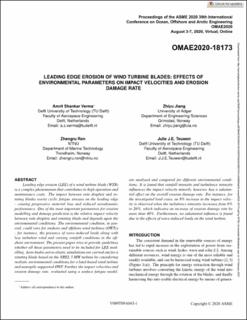| dc.description.abstract | Leading edge erosion (LEE) of a wind turbine blade (WTB) is a complex phenomenon that contributes to high operation and maintenance costs. The impact between rain droplets and rotating blades exerts cyclic fatigue stresses on the leading edge — causing progressive material loss and reduced aerodynamic performance. One of the most important parameters for erosion modelling and damage prediction is the relative impact velocity between rain droplets and rotating blade and depends upon the environmental conditions. The environmental condition, in general, could vary for onshore and offshore wind turbines (OWTs) — for instance, the presence of wave-induced loads along with less turbulent wind and varying rainfall conditions in the offshore environment. The present paper tries to provide guidelines whether all these parameters need to be included for LEE modelling. Aero-hydro-servo-elastic simulations are carried out for a rotating blade based on the NREL 5 MW turbine by considering realistic environmental conditions for a land-based wind turbine and monopile-supported OWT. Further, the impact velocities and erosion damage rate, evaluated using a surface fatigue model, are analysed and compared for different environmental conditions. It is found that rainfall intensity and turbulence intensity influences the impact velocity minorly, however, has a substantial effect on the overall erosion damage rate. For instance, for the investigated load cases, an 8% increase in the impact velocity is observed when the turbulence intensity increases from 6% to 26%, which indicates an increase of erosion damage rate by more than 40%. Furthermore, no substantial influence is found due to the effects of wave-induced loads on the wind turbine. | en_US |
